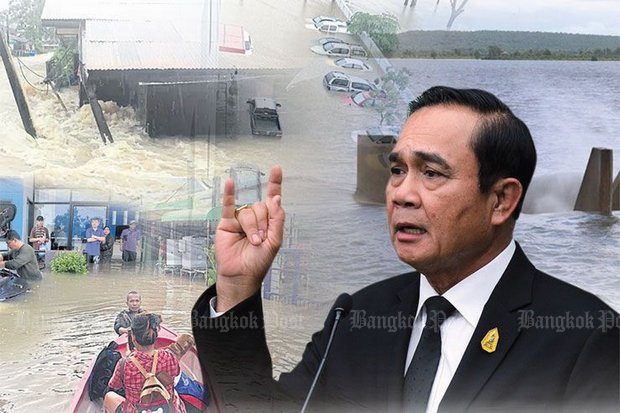
By the time Prime Minister Prayut Chan-o-cha arrived in Sakon Nakhon yesterday to inspect the flood situation, the water must have drained away in many areas, leaving only traces of the severe damage the floods brought.
The flooding that hit Sakon Nakhon and nine other provinces, mostly in Isan, has severely damaged these areas, causing social and economic loss. The next province likely to suffer a similar catastrophe is Nong Khai, a border province on the Mekong River.
After this, the government is expected to allocate a huge budget for flood relief and infrastructure repair.
The government blames the heavy downpours that battered the Northeast on the Sonca storm, and has unjustifiably accused those who spoke out to criticise the authorities' poor handling the situation of politicising the issue.
But those critics are right in pointing out that the floods epitomise old problems in this country: poor city planning and weak law enforcement regarding land use in the wake of unplanned urbanisation.
Poor responses to a given situation, a lack of effective early warning systems, as well as evacuation plans aggravate the problems.
Sakon Nakhon is not alone. These problems are found in most, if not, all parts of the country, from north to south, Isan and the Central Plains. That explains why heavy flooding is so frequent and brings more serious impacts.
The pattern is more than familiar. Old waterways and ponds that once served as water-retention areas that alleviated flooding are gone, or illegally occupied by people with money, while poorly designed roads and other large infrastructure projects, in particular housing or industrial estates, effectively block water flow.
The Sakon Nakhon disaster resembles the "Big Flood of 2011" which caused damage on a larger scale. News reports suggested that, like 2011, all local reservoirs were full and not capable of receiving more rainwater. In Sakon Nakhon, the heavy downpours that began on July 26 were said to have hit a 50-year record, 465 millimetres in three days.
There are reports that irrigation officials had to release an enormous mass of water from the swollen Huay Sai Kamin Reservoir, a move that triggered speculation that there were cracks in the structure. The Irrigation Department staunchly denied this.
In fact, the 2011 floods were a wake-up call for the country that it needed effective city planning and also a comprehensive water management scheme. We have also lost too many water-retention areas which has crippled efforts to deal with floods. Unfortunately, little has been done to correct the problems and we are stuck with the same old issue of too much talk and not enough action.
Sad to say, the eagerness to seek long-term measures simply fizzles out until the next flood hits.
With all the power he has, Prime Minister Prayut must tackle this challenge and lay to rest this chronic problem. He has to order the Highways Department to examine all roads across the country, single out those that block water drainage and solve the problems, by putting in place large pipes underneath or finding ways to channel the water into rivers.
Moreover, Gen Prayut must ensure those responsible for city planning -- local authorities and agencies -- do their jobs, toughen law enforcement, and restore old waterways. In doing so, they may be able to confront violators with money and power.
The prime minister must also provide support to these authorities, enabling them to work for the public.
We need long-term measures to cope with flooding, and that requires strong political will.
